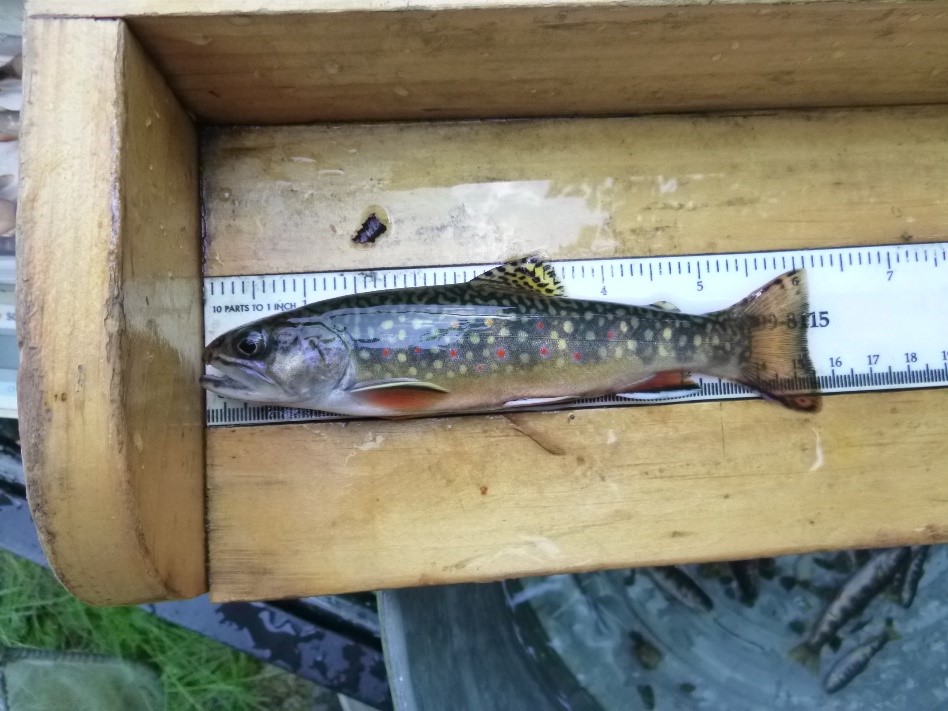Nineteen Years of Wild Brook Trout Monitoring
Mar. 23rd 2017In November 2016, the Vermont Monitoring Cooperative a Monitoring Update for data year 2015. In addition to updates to all the findings presented in 2014, this year includes a new section on 19 years of trout population monitoring in Ranch Brook courtesy of Vermont Fish and Wildlife fisheries biologist Rich Kirn.
Brook trout (Salvelinus fontinalis) is a native species highly prized by anglers and indicative of excellent water quality. The Vermont Department of Fish and Wildlife began monitoring wild brook trout populations in the West Branch of the Little River and Ranch Brook in 1997, initially due to the potential effects of ski area development and snowmaking water withdrawals on brook trout populations. Because of their requirements for clean, cold water, the brook trout population record also provides valuable insights into the effects of broader environmental variables over the long term.
Trout population surveys were conducted annually from 1997 through 2015 within 3 stations in the West Branch and 2 stations in Ranch Brook. Trout surveys consisted of multiple run sampling with an electrofisher. Survey sections were generally 250 feet in length and conducted during the mid-summer months when stream flow had subsided and brook trout young-of-year (yoy) became large enough to sample.
Trout were measured and weighed to estimate populations within each sampling station using the removal method and the maximum weighted likelihood method developed by Carle and Strubb (1978). Population estimates were calculated for two age classes. The population estimates were standardized to represent number per mile for each age class and summed for the total brook trout population within each station.
After relatively low levels observed in 2014, natural reproduction of brook trout rebounded in 2015 with all stations supporting greater than 1,000 yoy/mile, an average increase of 190%. Yearling and older brook trout declined an average of 32% in 2015. Population estimates for both age classes remained within the range observed over the 19 years of study.
The West Branch and Ranch Brook supported high quality brook trout populations maintained through natural reproduction consisting of multiple age classes and averaging over 1500 trout per mile over the 19-year study. Wild brook trout populations vary considerably among and within streams due to differences in habitat conditions and localized land use effects while broad environmental variables may have significant temporal effects. While large fluctuations were observed for each age class both within and among the two study streams, no clear trends were evident.
Annual brook trout yoy production showed clear highs and lows, often consistent across the 5 stations and 2 study streams, suggesting the effect of broad environmental influences. Successful recruitment of yoy requires suitable habitat conditions over extended periods including fall spawning, overwinter incubation and spring emergence. In some years peak yoy production was followed by commensurate increases in the yearling and older population such as those observed in 1999-2000 and 2012-2013. Yearling and older brook trout populations tend to be more stable and can rapidly recover following extreme events. For example, very high flow events in the summer of 2010 and spring 2011 may have contributed to the yearling and older brook trout declines observed in some stations, but these populations rebounded to above average levels by 2013.
Increased stream temperature and flood frequency due to climate change suggest a continued loss of brook trout populations throughout their range. Forested watersheds and riparian areas will be critical for the long-term persistence of Vermont’s wild brook trout populations as they serve to moderate water temperatures and streamflow, improve water quality, contribute cover, stabilize streambanks and floodplains and provide for complex and diverse aquatic habitats. Improving aquatic passage through the elimination of manmade barriers (e.g. culverts, weirs and dams) will also help ensure that brook trout are able to access critical habitats and recover from extreme natural events that reduce population levels.
 ecoNEWS VT
ecoNEWS VT